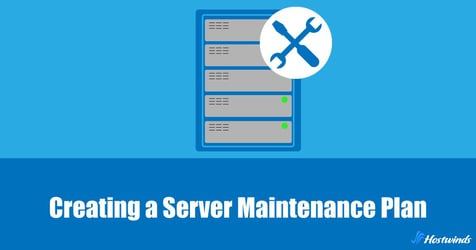Hostwinds Blog
Search results for:

Creating a Server Maintenance Plan
by: Hostwinds Team / October 27, 2023
Server maintenance is the backbone of a stable online presence. Neglecting it can lead to downtime, security vulnerabilities, and a host of other issues. In this guide, we'll take you through the essential aspects of server maintenance, ensuring your servers are always up and running.
What is a Server?
A server is a specialized computer designed to store, process, and deliver data to other devices, often over a network. It acts as the central hub for websites and applications, responding to user requests and serving content.
How Servers Work
Servers operate using a combination of hardware and software. The hardware includes components like CPUs, memory, and storage, while the software involves the operating system and server-specific applications.
Types of Servers
Servers come in various types, each tailored to specific functions. It's common for organizations to utilize multiple server types to support various functions within their IT ecosystem.
Understanding the role of these server types is essential when creating a maintenance plan, as different servers may require specific considerations and maintenance tasks to ensure their optimal performance and reliability.
Here are some of the most common server types:
Web Servers: Web servers are perhaps the most recognizable type. They handle the delivery of web content, including HTML, CSS, and other web assets. Popular web server software includes Apache, Nginx, and Microsoft Internet Information Services (IIS).
Database Servers: Database servers are responsible for storing, managing, and serving data. They are vital for applications that rely on databases for data storage. Prominent database management systems include MySQL, PostgreSQL, and Microsoft SQL Server.
Application Servers: Application servers are designed to execute and manage applications, providing a runtime environment for software. They play a pivotal role in hosting complex web applications and services.
File Servers: File servers focus on storing and sharing files across a network. They are often used in office environments to centralize file storage and facilitate access and collaboration.
Print Servers: Print servers are responsible for managing and controlling access to printers on a network. They enable users to send print jobs to networked printers.
Email Servers: Email servers manage the sending and receiving of emails. They use protocols like SMTP (Simple Mail Transfer Protocol) for sending emails and IMAP (Internet Message Access Protocol) or POP3 (Post Office Protocol) for email retrieval.
Virtualization Servers: Virtualization servers use hypervisors to run multiple virtual machines on a single physical server. This technology optimizes resource utilization and simplifies server management.
Proxy Servers: Proxy servers act as intermediaries between client devices and other servers. They can be used for various purposes, such as caching content, enhancing security, or controlling access to specific resources.
DNS Servers: DNS (Domain Name System) servers translate domain names (e.g., example.com) into IP addresses. They play a critical role in routing internet traffic.
Creating a Server Maintenance Plan
Server maintenance is not a choice; it's a necessity. Regular maintenance ensures server reliability, security, and optimal performance. Neglecting maintenance can lead to costly downtime and potential data loss.
A server maintenance plan outlines the tasks, schedules, and procedures needed to keep your server in top condition - It's your roadmap for server health.
Let's take a look at what a server maintenance plan should include:
- Server Assessment: Assessing your server's current state and identifying potential issues will give you a baseline for the types of tasks you should hyper-focus on as well as how often you should schedule maintenance tasks.
- Outline Tasks: List the specific tasks required for maintenance. This may vary depending on the type of server, but generally include updates, backups, and security checks.
- Set Schedules: Establish regular maintenance schedules. Some tasks like backups should be completed daily or weekly, while others can be placed monthly such as some software updates.
- Detailed Documentation: Maintaining detailed records of maintenance activities is the backbone of ensuring your servers are at peak performance. At the very minimum include what tasks were completed, when they were completed and by whom. This will make it easier to track changes and troubleshoot if something does go wrong.
Server Maintenance Tasks
As we mentioned earlier, server maintenance tasks may vary depending on the type of server with the exception of a few universal components. Let's dive a little deeper into those as well as a few more tasks you should consider including into your plan.
Data Backup
Regularly back up your server's data to prevent data loss in case of unexpected issues. Set up automated backup schedules and test your backup recovery process.
Software Updates and Patches
Keep your server's software and security patches up to date. Regularly check for updates and apply them promptly to patch vulnerabilities.
Security Review
Perform routine security reviews to identify and address potential security risks and vulnerabilities.
Temperature Checks (Physical)
Monitor the server's temperature to prevent overheating, which can lead to hardware damage. Ensure adequate cooling systems are in place.
Server Cleaning (Physical)
Regularly clean the server hardware to prevent dust buildup, which can affect performance and cooling.
Antivirus Configuration and Updates
Configure and regularly update antivirus software to protect your server from malware and security threats.
Disk Usage
Keep disk storage clean by regularly removing old or unnecessary files and logs.
RAID Alarms
Any server worth its weight will use RAID (Redundant Array of Independent Disks). These are important to ensure data integrity and recovery in the chance of a loss so monitoring RAID status is extremely important.
Server maintenance may seem daunting, but it's an absolute necessity. By understanding the components and processes of your server and creating a well-structured maintenance plan, you can ensure the longevity and reliability of your server.
Remember, server maintenance is an ongoing process. Regular checks, updates, and thorough care will keep your server in top condition, ensuring a seamless online experience for your users.
Written by Hostwinds Team / October 27, 2023
